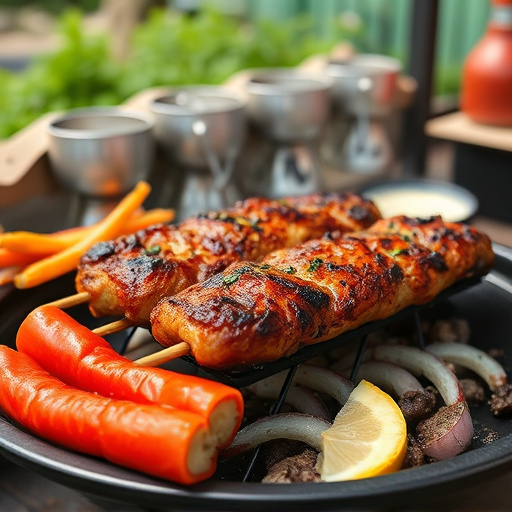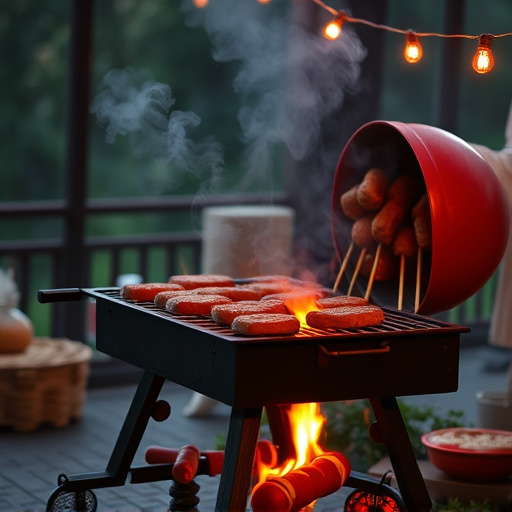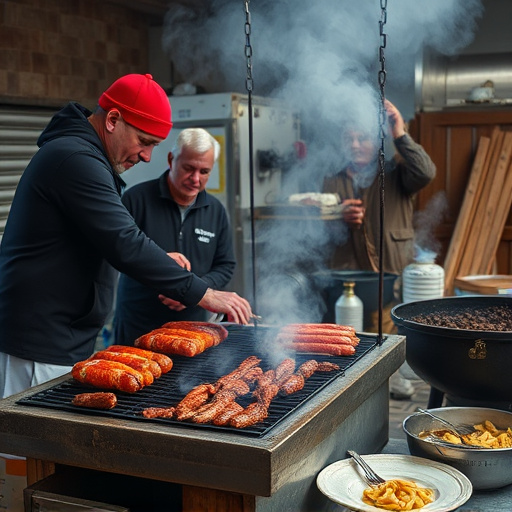Crafting perfect BBQ sausage links begins with selecting high-quality meat (pork, beef, or blends) and grinding it coarsely. Season with salt, pepper, garlic powder, onions, and herbs like rosemary or thyme. Shape the seasoned meat into links using casings for a classic look. A balanced meat blend creates the best BBQ sausage recipe, ensuring delicious, grilled links that satisfy taste buds at any gathering. For ultimate control over quality and flavor, grind your own meat; alternatively, use pre-ground meat but read labels carefully to avoid fillers or preservatives.
“Unleash the mouthwatering flavors of homemade BBQ sausage links – a grilled delight that’s perfect for any occasion! This comprehensive guide takes you on a journey from meat selection to serving suggestions. Learn the art of creating the ideal sausage blend with pork, beef, or chicken, and decide between grinding your own meat or using pre-ground options. Discover secret seasonings, master shaping techniques, and explore various grill cooking methods. Plus, find out how to store your leftovers and impress friends and family at every meal with this easy and versatile BBQ sausage recipe.”
- Selecting and Preparing Meat for Sausage Links
- – Choosing the right meat blend (pork, beef, chicken, etc.)
- – Grounding your own meat at home vs. using pre-ground meat
Selecting and Preparing Meat for Sausage Links

When it comes to crafting delicious BBQ sausage links, the quality of your ingredients is paramount. Start with fresh, high-quality meat as a foundation for your homemade sausages. You can opt for traditional pork or beef, or even mix and match for a unique flavor profile. The key is to choose cuts that are lean yet flavorful, such as shoulder or chest for pork, and eye of round or brisket for beef.
Preparing the meat involves coarsely grinding it to ensure a textured result. Seasoning is crucial; a blend of salt, pepper, garlic powder, and onions can enhance the sausage’s taste. You can also add herbs like rosemary or thyme for an aromatic twist. After mixing well, shape the seasoned meat into long links, securing them with casings for that classic sausage look. This meticulous selection and preparation are essential steps in crafting mouthwatering BBQ sausage links ready to sizzle on your grill.
– Choosing the right meat blend (pork, beef, chicken, etc.)

When crafting your own BBQ sausage links, selecting the perfect meat blend is a key step to success. Traditional choices for sausage include pork and beef, offering a classic, rich flavor profile that pairs well with grill smoke. For a leaner option, chicken can be substituted, resulting in a lighter sausage that still delivers tremendous taste. Consider the desired texture and fat content when making your selection; pork tends to provide a finer grind while beef offers a heartier, chewier bite.
A bbq sausage recipe thrives on balance, so experiment with combinations of these meats or even add a touch of veal for enhanced flavor and moisture. The right blend will not only satisfy your taste buds but also ensure the sausage holds its shape beautifully when grilled, allowing you to enjoy perfectly cooked links that are sure to be a crowd-pleaser at any gathering.
– Grounding your own meat at home vs. using pre-ground meat

When it comes to crafting your own BBQ sausage links, one of the key decisions is whether to grind the meat at home or opt for pre-ground options. Grinding your own allows for complete control over the quality and type of meat used. This is especially beneficial when sourcing local, grass-fed livestock or selecting specific cuts to suit your desired flavor profile. By doing it yourself, you can ensure a consistent texture and taste that aligns perfectly with your bbq sausage recipe.
On the other hand, pre-ground meat offers convenience, especially for those short on time or without access to a meat grinder. These products are usually available in various flavors and can be a great base for experimenting with different spices and sauces. However, store-bought pre-ground meats may contain fillers or preservatives, so reading labels is essential for health-conscious cooks.
